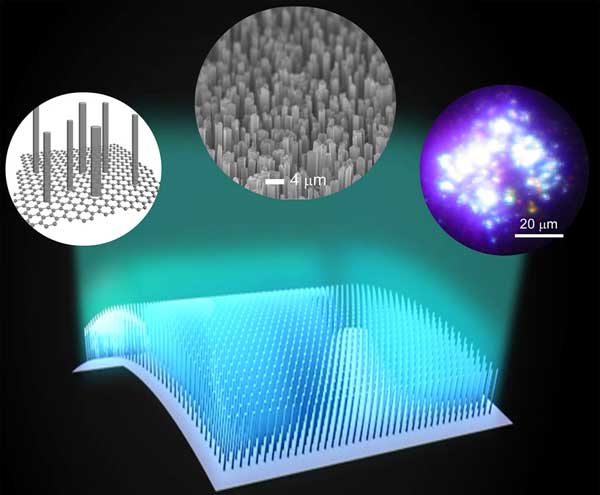
[Image above] Brighter light emitting diode (LED) displays made with perovskite materials may be just beyond the bend, but so, too, are bendable and stretchable ones, thanks to scientists from Seoul National University. Credit: Seoul National University
What could you do with a more “bendy” LED?
Brighter light emitting diode (LED) displays made with perovskite materials may be just beyond the bend, but so, too, are bendable and stretchable ones, thanks to scientists from Seoul National University. (Bend: See what I did there?)
Their work, published in APL Materials, shows how the team, led by Gyu-Chul Yi, used gallium nitride (GaN) semiconductor micro-rods on graphene to create “transferrable LEDs” that lead to more flexible, yet reliable, devices.
“GaN microstructures and nanostructures are garnering attention within the research community as light-emitting devices because of their variable-color light emission and high-density integration properties,” says Yi in an American Institute of Physics press release. “When combined with graphene substrates, these microstructures also show excellent tolerance for mechanical deformation.”
Flexible electronics aren’t new, but current offerings (such as this roll-up-like-a-poster OLED panel TV from LG) generally utilize organic materials. Their inorganic counterparts, which provide “superior optical, electrical, and mechanical properties,” come with their own set of challenges, in that they aren’t easily grown on a flexible substrate.
Not so for these LEDs.
These GaN LED microstructures are produced using the team’s previously developed catalyst-free metal-organic chemical vapor deposition process, a technique that, according to Yi, “is necessary to maintain high crystallinity, control over doping, formation of heterostructures and quantum structures, and vertically aligned growth onto underlying substrates.”
Substrate-of-the-moment graphene—which has shown great flexibility and mechanical strength, as well as stability (chemically and physically) at high temps—was selected because its ultrathin surfaces provide a “stable and inactive surface” upon which GaN could grow.
Not only were these GaN-grown-on-graphene LEDs more bendy—maintaining their optical performance without any “significant” degradation after 1,000 bending cycles—but they also exhibited an “intense” electroluminescence, says lead author and SNY graduate student Kunook Chung.
The team hopes that their work might translate into more flexible, wearable, and affordable inorganic LEDs and solar cells.
The open-access paper is “Growth and characterizations of GaN micro-rods on graphene films for flexible light-emitting diodes” (https://dx.doi.org/10.1063/1.4894780).
Author
Jessica McMathis
CTT Categories
- Electronics
- Energy
- Manufacturing
- Material Innovations
- Optics


